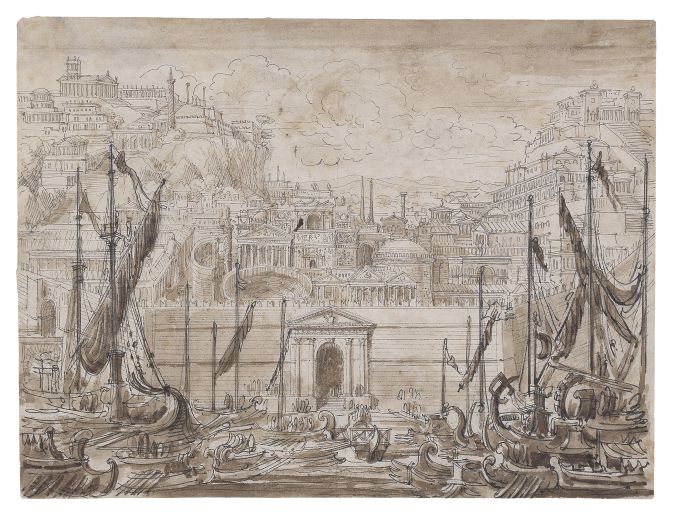Fantasy capriccio of a classical city and harbour.
Antonio Basoli
* 1774 in Bologna † 1848 in Bologna
Pen and black ink, and brown wash over graphite. Size of sheet: 18.5 x 24. 5 cm.
Watermark: P.M. Fabriano of an urn with acanthus plant.
Provenance: Le chevalier Gian-Carlo Rossi (active in Rome mid to late 19th century), his sale, 17 March 1886 at H.G. Gutekunst, Stuttgart. (Lugt 2212)
Probably a draft for the Raccolta / di Prospettive serie, Rustiche, e di Paesaggio (1) ... , particularly for plate XXIV (Antico Porto …) and plate XXXV Porto (Schizoid presco l’ Autore).
Two similar drawings are at the National Gallery of Art, Washington (1994.9.3&4).
To transfer his stage designs to print reproductions Basoli employed a large number of assistants, including his brother Luigi and prominent reproductive engravers such as Francesco Cocchi, Gaetano Sandri and Giulio Tomba. The individual prints bear dedications to fellow artists and teachers at the academy in Bologna, such as Francesco Rosaspina, Felice Giani and Pelagio Palagi.
Antonio Basoli is considered to be one of the most ingenious and prolific Italian theatre painters and stage architects in the first half of the Ottocento. Having undergone extensive training at the Accademia Clementina in Bologna, where he was taught amongst others by Gaetano and Mauro Gandolfi, Angelo Venturoli and Vincenzo Mazzi, Basoli was appointed as scene painter at the Teatro Taruffi in Bologna in 1793 even before he had completed his studies. He broke with the Baroque tradition of Bibiena at an early stage and embraced Neo-classicism. Basoli’s artistic activities were concentrated to an almost excessive degree on theatre painting, which explains the very large number of stage designs he produced, most of which have survived in the form of reproductive prints. In the course of his successful career Basoli was active inter alia in Triest, St. Petersburg, Rome and Milan, although Bologna remained the centre of his activities. His lengthy period as a teacher at the city’s academy (1815–1848) enabled him to exert a lasting influence on the following generation of artists. See also: Peter Fuhring, Design into Art, Drawings for Architecture and Ornament, The Lodewijk Houthakker Collection, vol. 2, London, 1989, p.631.
From the collection of the eminent book collector, who assembled next to Italian Old Master drawings also drawings related to illustrated books. (Enfin des dessins de l'école italienne nos 1332-1492), le Pérugin, Signorelli, Ghirlandajo, Raphaël, Giov. da Udine, della Robbia, puis des livres illustrés, livres de broderies, etc.) see Lugt 2212.
(1)Raccolta / di Prospettive serie, Rustiche, e di Paesaggio / … Inventate / da Antonio Basoli … Disegnate / da Francesco Cocchi … Incise da diversi Scuolari del Professore Francesco Rosaspina dall‘Autore, e dal Disegnatore. With engraved title vignette and 102 etchings. Untrimmed copy in half-leather binding with coloured paper cover, ornamental gilt and lettering on the spine. Bologna, published by the artist, 1810. Berliner Ornamentstichsammlung 4165; Millard IV, 15; Brunet I, 692; Ebert 1752.
£ 6500.-
